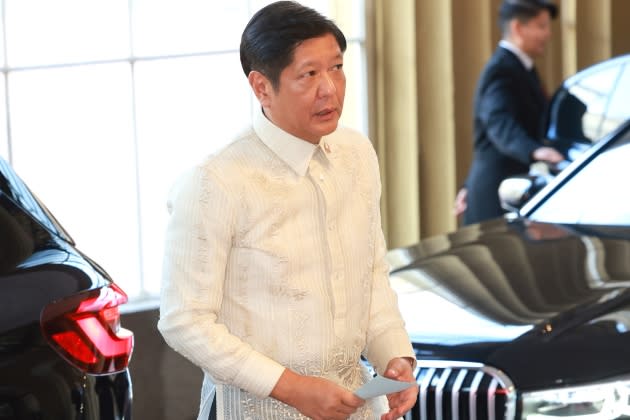Remembering Fashion Designer Pepito Albert
- Oops!Something went wrong.Please try again later.

Friends and fanily are taking part in a nine-day novena for the fashion designer Pepito Albert, who died Saturday at the age of 63.
Albert, who had studied fashion and started his career in the U.S., died of cancer at his home in Manila, according to fellow Filipino-born designer Josie Natori.
More from WWD
King Charles III's Coronation Reception for Overseas Guests With Kate Middleton, Jill Biden and More
Albert graduated from the Fashion Institute of Design & Merchandising in Los Angeles in 1986, and remained Stateside in the U.S. to venture into fashion. From the start the designer strived to appeal to strong women with a certain gravitas. He was also a fashion resource for the first family in the Philippines including former first daughter Irene Marcos-Araneta. President Ferdinand “Bongbong” Marcos Jr. reportedly wore Albert-designed barongs for such key appearances as King Charles’ coronation in London in May and a state visit to the U.S. to meet President Biden.
Having befriended Albert in the late ’90s, when she had formed the Fashion and Design Council of the Philippines, Natori said, “He was one of the leading designers in the Philippines. He had a very modern and clean approach. He was quite looked-up to. He had an amazing taste level and dressed a lot of the society women, including the first lady [Liza Araneta Marcos] over the inauguration.”
Over time, Albert added accessories to his design portfolio and became involved with the arts, having amassed a sizable art collection. The eldest in a large family, Albert looked after his siblings. “He had such a sense of humor and was very opinionated. People, who loved him, loved him so,” said Natori. “But if you crossed him….He was fun. He had absolutely amazing taste. In the end, he had rooms full of art and he was buying and selling art.”
In the late ’80s, Albert explained that his aim was to make women look smart, powerful and avant-garde, but not vulgar. After starting his eponymous company in 1987, the designer favored accentuated waistlines, narrow silhouettes, clean geometric lines, transparent touches and the occasional Grace Kelly-inspired sunglasses for added panache. Catering to specialty stores in the late ’80s, Albert generated about $400,000 in wholesale volume in 1998 — a decent output for a collection that retailed between $90 and $180.
As the years peeled away, Albert elevated his creations and became a favorite resource for socialites and political spouses. In 1992, he returned to the Philippines and opened a bespoke business. Albert also dabbled in jewelry. In 2009, he shifted gears a bit to launch his first full accessories collection called XVIA3 that drew upon cross-cultural references and was partially inspired by traditional Filipino jewelry. Inclined to add elements that were intentionally “slightly off,” such as 14-karat yellow gold-dipped silver, Albert also touched upon his heritage with such accents as the national sampaguita flower and the “pabatin,” a pinata-like toy for children.
Albert’s preferred accessory of choice was a Spanish fan that seemed to be a wink at his elusive public persona. Testimony to that was his preference for group shows versus solo ones. Despite that, he had a loyal following of high-profile clients, including the actress Dawn Zulueta-Lagdameo. In February, he participated in a group show at the Pintô Art Museum titled “Algodon” with JC Buendia, Tonichi Nocom, Barba, and Randy Ortiz. He was also partial to the model Jo Ann Bitagcol. Media-shy as Albert was, he was known to be a willing mentor to aspiring and young designers.
Natori enjoyed “a lot of Champagne dinners” with Albert, whom she last dined with a few months ago in Manila along with the prominent chef Margarita Forés, and the friendly trio wrapped up the meal with some shopping at a Dior boutique. The two designers related to each other in part since Albert had started his career in the U.S. When his health continued to falter in recent months, Natori kept the goodwill going by sending him steaks, a favorite indulgence, and books like Truman Capote’s “Unanswered Prayers.”
Albert’s friends and relatives had first started saying novenas for a cure for him a few years ago. The nine-day one that is underway is sometimes customary in the Philippines, in lieu of a wake or funeral. Natori said of “the one-of-a-kind” Albert, “I know that he was loved by many.”
He is survived by two of his brothers, whose names were not immediately known.
Best of WWD
